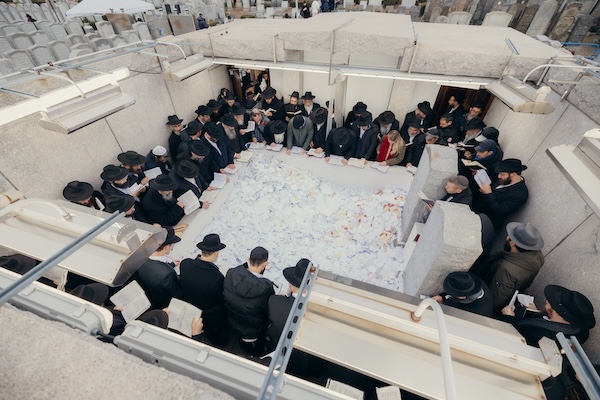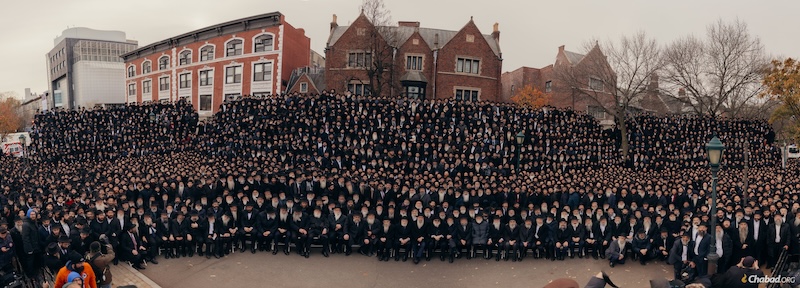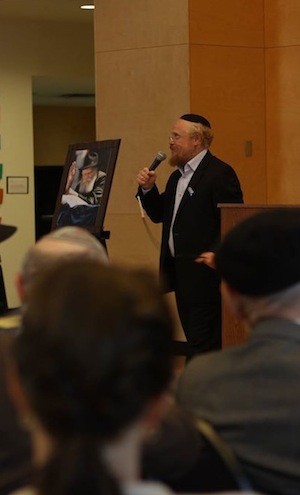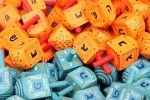Thousands of rabbis pose for a group photo in front of Chabad-Lubavitch world headquarters in Brooklyn, NY, on Dec. 1. (photo by Shmulie Grossbaum/Chabad.org)
Some 6,500 Chabad rabbis and Jewish leaders from around the globe gathered Nov. 27-Dec. 1 in Brooklyn, NY, for the annual International Conference of Chabad-Lubavitch Emissaries, the largest rabbinic gathering in the world.
Attending from British Columbia were Rabbi Yechiel Baitelman (Chabad Richmond), Rabbi Binyomin Bitton (Chabad of Downtown Vancouver), Rabbi Mottel Gurevitz (Tri-Cities Chabad), Rabbi Shmuel Hecht (Okanagan Chabad House), Rabbi Meir Kaplan (Chabad of Vancouver Island), Rabbi Dovid Rosenfeld (BC Regional Hebrew Schools), Rabbi Bentzi Shemtov (Chabad Nanaimo and Central Vancouver Island) and Rabbi Yitzchok Wineberg (Lubavitch BC).
While the yearly conference has a celebratory feel, welcoming rabbinic leaders from Alaska to Zambia, the past year was a difficult one for the Jewish people, seeing tragedy in Israel, and elsewhere. For Jews around the globe and the family of emissaries in particular, the days just prior to the conference were especially difficult: on Nov. 25, Abu Dhabi-based Chabad Rabbi Zvi Kogan was buried in Israel, after being murdered by terrorists in Dubai at the age of 28.
Chabad-Lubavitch emissaries, known as shluchim, are husband-and-wife teams who dedicate their lives to strengthening Jewish life in communities worldwide, often in remote locations without established Jewish infrastructure. They aim to reach both affiliated and unaffiliated Jews, welcoming Jews from all walks of life.
The annual conference, also known as the Kinus Hashluchim, unites rabbis and lay leaders from all 50 US states and more than 100 countries and territories around the world for four days of workshops, networking and spiritual uplift. The conference concludes with a gala banquet, which brings all the Chabad rabbis and their guests together in a giant conference centre in New Jersey.
The Thursday was a day of catch-ups between colleagues, as well as the first of a series of workshops on contemporary issues that ran over the weekend. Topics included disaster relief, combating hate, education, counseling and dealing with grief. Conference-goers who serve students on college campuses where Chabad has become part of Jewish life participated in a separate track, discussing issues specifically relevant to campus communities.
The Friday visit to the Ohel, in Queens, NY, the resting place of the Rebbe, Rabbi Menachem M. Schneerson, of righteous memory, marked the pinnacle of the conference. The emissaries came to pray for their families and communities, carrying with them countless prayer requests. Many came with handwritten letters from Jews in their hometowns and read them by the holy site. The Ohel visit culminated in the reading of the pan klali (“general letter”) that was signed by all emissaries and contained prayers for Israel, the Jewish people and humanity at large.

With the onset of Shabbat on Friday evening, the emissaries spent the Jewish day of rest in prayer and brotherly camaraderie, often in the company of family and friends.
Sunday morning saw the snapping of the annual “class picture” under the iconic gables of 770 Eastern Parkway, the headquarters of the Chabad-Lubavitch movement, and perhaps the most recognizable Jewish building in the world. The photo, featuring thousands of black-hatted rabbis, represents not just an annual tradition but also the many faces of the Chabad rabbis who bring Judaism to the world, from wartorn Ukraine to the towns along Israel’s hostile borders, to anti-Israel-filled college campuses across North America, to sleepier towns in quieter places.
The capstone of the conference was the gala banquet, held at the New Jersey Convention and Expo Centre, a powerful moment of remembrance and resilience. Speakers honoured Kogan with emotional tributes that emphasized the importance of continuing their global mission. The conference linked by video with the home of Kogan’s parents in Jerusalem, where his family was sitting shiva, and all 6,500 gathered shared the traditional text of comfort with the family.
Rabbi Yehuda Krinsky, chair of Merkos L’Inyonei Chinuch – Chabad’s educational arm – greeted the audience, sharing words of consolation with Kogan’s family and the emissaries, his “extended family,” and sending prayers for the Israeli soldiers defending the Holy Land, as well as the hostages still held in Gaza.
A video tribute was made for Rabbi Moshe Kotlarksy, the vice-chair of Merkos L’Inyonei Chinuch, who passed away after a lengthy illness on June 4. Kotlarsky was well-known for his role in the annual Kinus Hashluchim, directing an army of planners, staff and volunteers to ensure every detail of the massive event was perfect.
Among the most inspiring presentations of the evening was that of Rabbi Yehoshua Soudakoff, director of Chabad for the Deaf Community in Israel, who spoke of his path to finding his Jewish self as a deaf Jew.
“The voice you hear is not mine, but the words definitely are,” he said through an interpreter. “It is hard for a deaf person to find a place within the community. Torah and mitzvah while deaf are difficult. That is why I established Chabad for the Deaf Community. There are deaf Jews and Jews with various disabilities throughout the world. Let us continue our holy work to reach out to every single one of them and inspire them, just as I was once inspired,” he said to applause.
The gathering culminated in a roll call of Chabad emissaries. The event featured multilingual welcomes from emissaries around the world, including a notable announcement that a new Chabad couple had been dispatched to Andorra, highlighting Chabad’s ongoing expansion.
The evening concluded with dancing, the assembled rabbis united in their determination to continue their mission of Jewish outreach and community building, regardless of the challenges they face.




